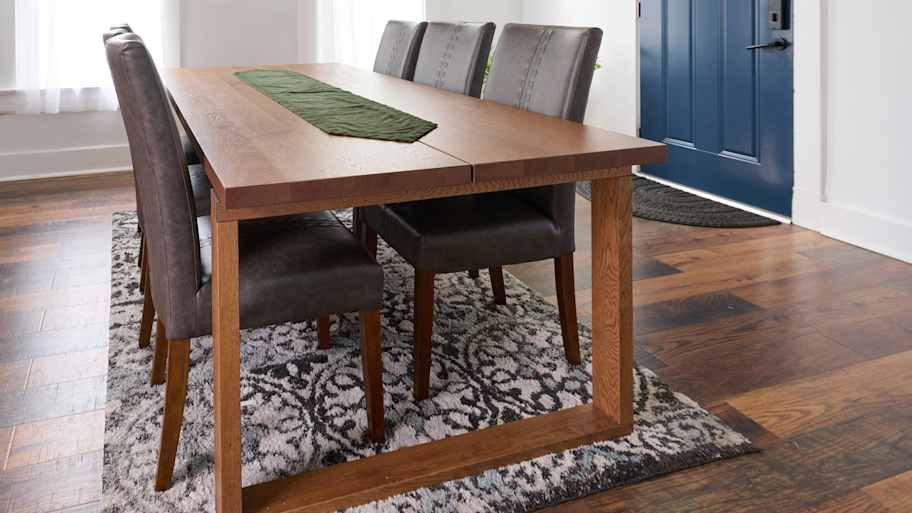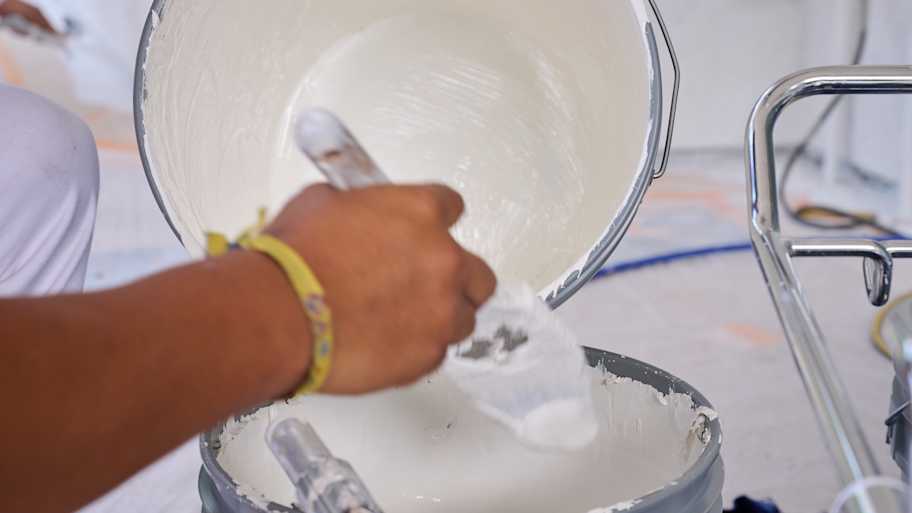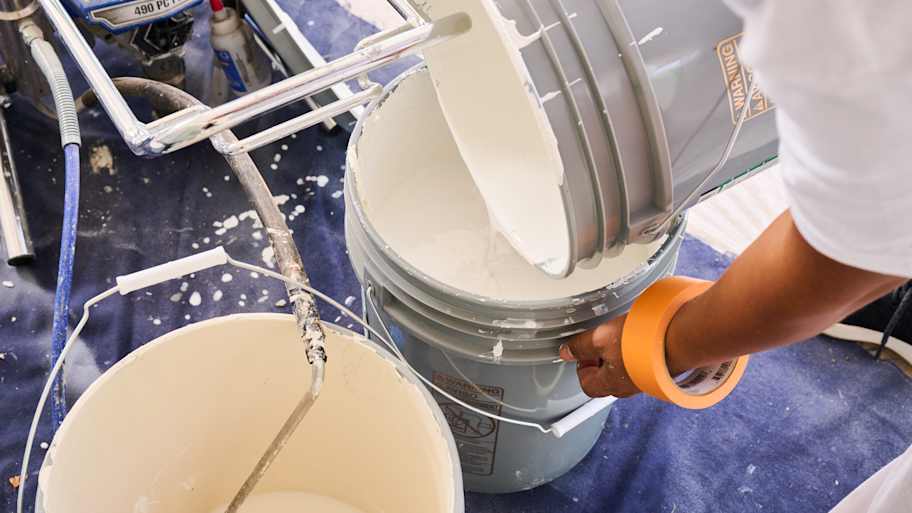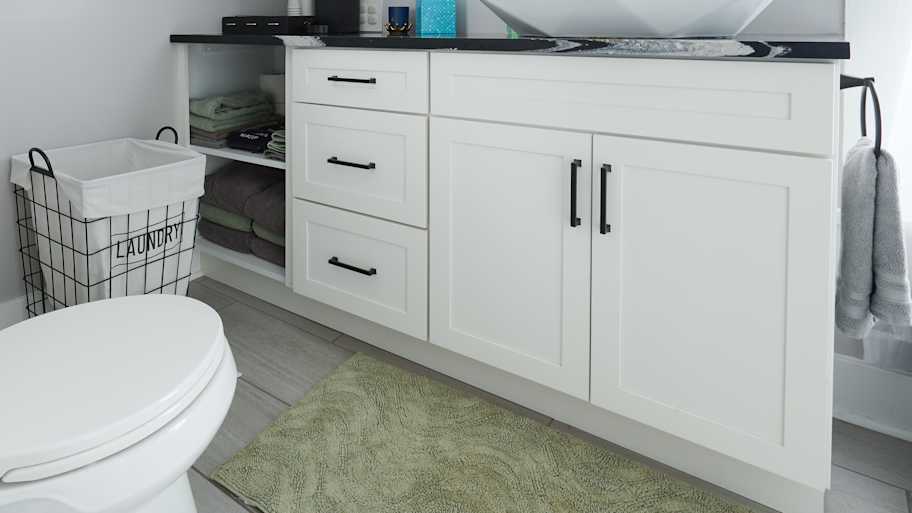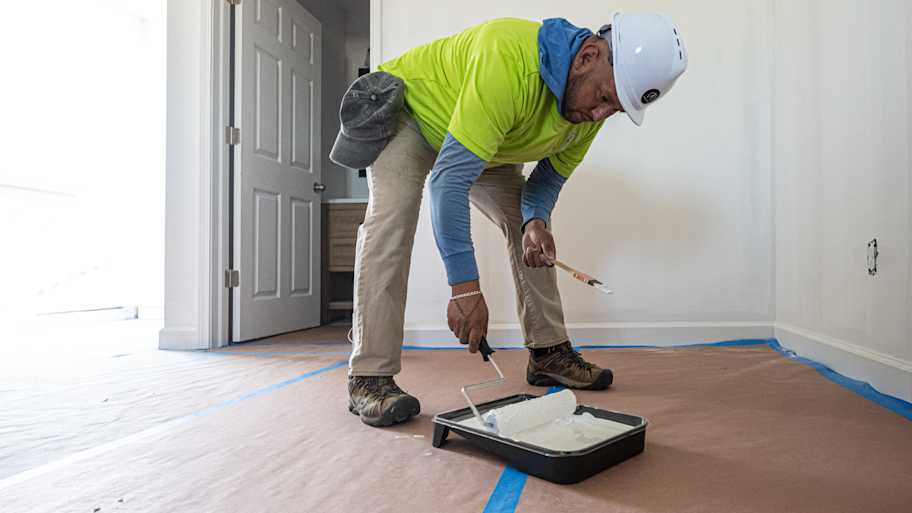Stained vs. Painted Trim: Which Is Better for Your Home?
One can hide your wood, while the other can help it shine


Stain sinks into wood, whereas paint sits on top.
Paint is best for humid rooms, but doesn’t always hold up well to daily wear.
Stain provides a natural look that isn’t easily scuffed.
You’ll have to remove trim before you can stain it.
You can paint trim and walls at the same time to reduce costs.
Trim has a surprising wealth of opportunities. It’s a blank canvas that can completely change the mood of a room. The right crown molding can instantly elevate a space, conjuring images of stately homes. In other ways, it’s just practical. Baseboards can hide flooring imperfections and protect your wall from scuffs—but how do you finish it?
If you’re torn between stained trim versus painted trim, the answer really depends on what you’re going for. Both have their strong points, but the ultimate decision should be based on how you want your room to look and feel. Let’s get into it.
Stained Trim vs. Painted Trim
So, should you paint or stain your trim? In order to find the right answer, you need to think about your overall project. It’s not always so cut and dry, either. Where stain is vulnerable in exterior applications, it’s strong in interior applications. Paint, on the other hand, is an all-around good option. It really depends.

Price
If you’re looking purely at the price of materials, stain typically costs less than paint. That doesn’t mean stained trim costs less than painted trim. In fact, staining can cost significantly more if you hire a local interior painting company.
You’ll need to start with higher-quality wood, and if the wood is particularly porous, you’ll need a lot more stain than you might think. If you’re hiring a pro for refinishing, you’ll need to pay additional costs to remove and reinstall the trim.
With paint, a contractor can do your walls and trim at the same time, which drives down the cost. No removal and reinstallation are required.
Most Affordable: If you’re just buying the material, stain. If you’re doing a whole professional project, paint.
Appearance
Stain has a translucent appearance that tints wood and shows off the natural wood grain. Paint is completely opaque and hides the natural look of wood. It also comes in various sheens, so you won’t need to apply a lacquer if you want high-gloss.
Best Appearance: Depends on personal preference
Options and Customization
Most stains only tint wood. An oil-based stain can provide more coverage, but color options are still limited. Most of the time, it’s just meant to enhance the natural color of your wood.
Paint, on the other hand, has more versatility. You can purchase paint in just about any color and almost any finish, whether it’s matte chalkboard paint or ultra glossy. You can even make your own custom mixes.
Most Versatile: Paint
Durability
Paint—especially in high-traffic areas—is prone to cracking, chipping, scuffing, and peeling. A vacuum can do a number on a painted baseboard.
Stain, on the other hand, soaks deeper into the wood so it’s less susceptible to damage from daily wear, though it is vulnerable to UV-related fading. In general, paint requires more touch-ups in interior applications, but it’s easier to touch up.
Most Durable: Stain
Water Resistance
Stain is porous, so it’s not water-resistant. Even oil-based stain still isn’t a sealant, so it’s not the best choice for interior trim in humid areas of the home (think: bathrooms, kitchens, and finished basements).
Paint, on the other hand, can act as a sealant—especially if you use an acrylic or epoxy-based paint. Some paint can even deter mold.
Most Water-Resistant: Paint
Life Span
Inside your home, there’s not a huge difference between the life span of paint and stain. Outside, you’ll need to restrain more often than you’ll need to repaint (chalk it up to rain, snow, and sun).
On your indoor trim, you might actually find yourself needing to repaint more often because of chips and cracks. Keep in mind that stain-grade trim is made from higher-quality materials so it generally lasts longer.
Longest Lasting: Stain
DIY-ability
Painting is a common DIY job, and painting molding and baseboards is relatively simple. You can even paint them after installation as long as you're careful with your painter’s tape.
Staining your trim takes a little bit more effort. You’ll have to remove the trim and sand it down so the stain can absorb evenly (versus simply using a good primer like you would before painting). After that, you’ll have to reinstall the trim, which may require the help of a local trim or molding installer if you’re not super handy.
Best DIY: Paint
Ease of Repair
Many homeowners paint their own walls and ceiling trim—and the same goes for making their own repairs. Unless it’s seriously damaged, you can touch up painted trim by simply applying another coat of paint.
With stain, you can touch up small nicks using a stain marker in a similar color. Unfortunately, to hide more serious signs of wear, you’ll need to remove, strip, and restain the entire piece of damaged trim.
Easiest to repair: Paint
Return on Investment
There’s a lot of debate on whether or not trim improvements can increase your home's resale value. Since you’ll typically only use stain on high-quality wooden trim, it’s worth a little bit more than painted trim.
But that doesn’t necessarily mean it’ll drastically impact the price of your home when you go to sell. Some buyers love crown molding or picture frame molding, and others just don’t. It really depends on the buyer, but with all aesthetic improvements, it’s probably not doing you any favors if it doesn’t match the style of your home.
Biggest return on investment: Whichever best matches the style of your home
Stained Trim Pros and Cons

Stain and paint are quite different from each other. Stain will sink into your trim, creating a sheer tint that shows off the natural wood grain. It enhances—without completely hiding—natural wood. Solid stains (which are typically oil-based rather than water-based) have more pigment than normal stains and will offer your trim a little bit of protection. You won’t need a topcoat either, but it will be more difficult to refinish trim with stain once it’s already been painted. You’ll need to remove the trim and strip the paint first.
Pros of Stained Trim
Timeless appearance
Enhances the look of natural wood, allowing the wood grain to shine
Lasts longer than paint
Not prone to scuffs and chips
Easy to apply to unfinished trim because you won’t need to prime
Oil-based wood stain can prevent trim from cracking and peeling as it ages
Water-based wood stain produces few VOCs
Cons of Stained Trim
Shows flaws in wood, so your trim has to be high quality
Must strip your trim before staining
Does not waterproof a surface, so it’s a poor choice for bathrooms and kitchens
Limited color and finish options
Can take 24 to 48 hours to dry and cure
Painted Trim Pros and Cons
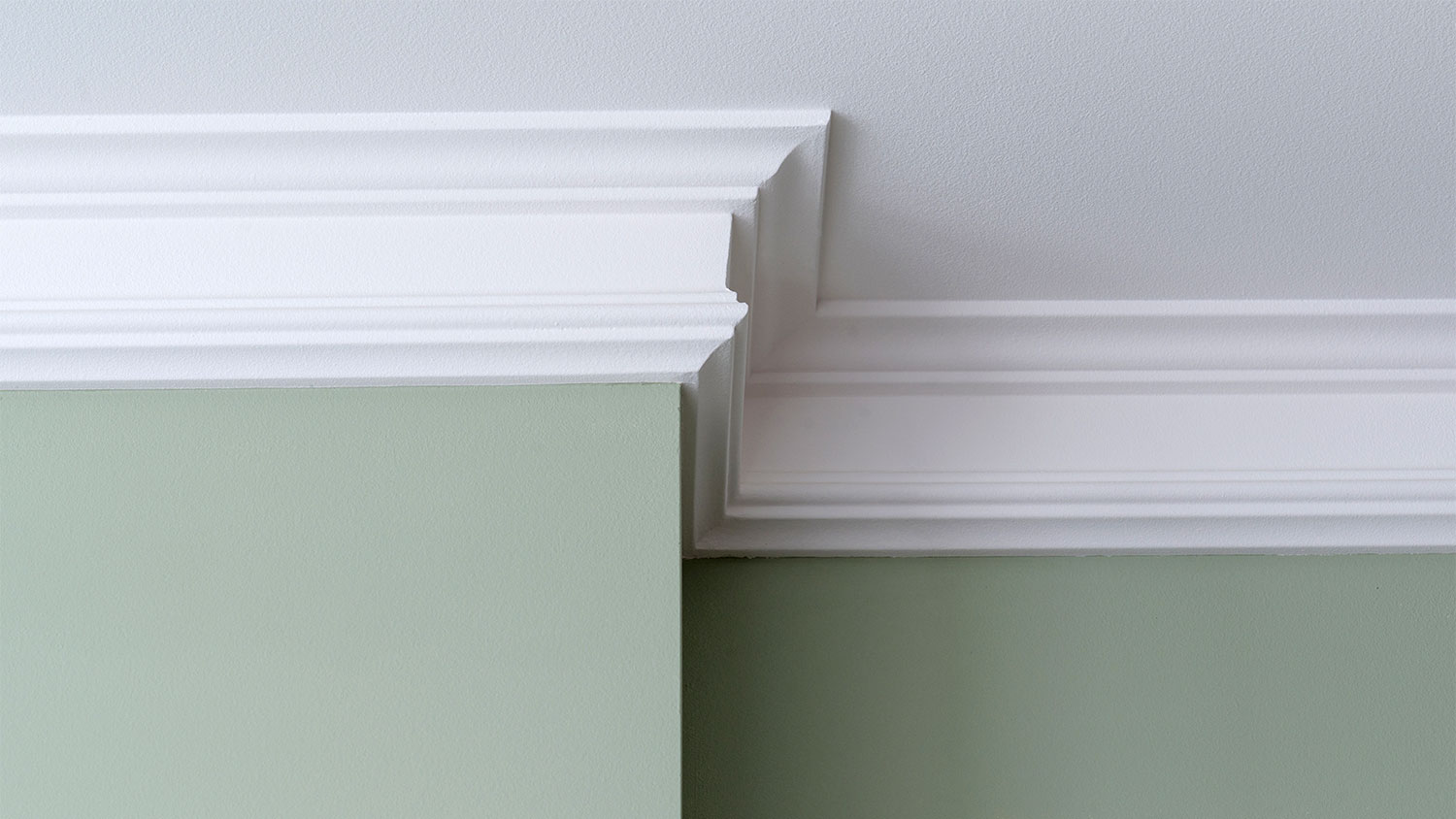
Unlike stain, paint sits on the surface of your trim. It’s opaque rather than translucent, and as a result, it’s an excellent way to hide imperfections found in low-quality wood. Paint dries relatively quickly, and you can paint over your existing trim as long as you use a good primer to help it adhere. It makes the whole process a lot easier, and there are options for every room. For example, if you want to paint trim in your bathroom or laundry room, you can use an acrylic enamel or epoxy-based wall paint.
Pros of Painted Trim
Comes in almost any color imaginable
You can paint trim after installation, making it easier to change or repair
Completely hides wood (which is great if your trim has imperfections or is low-quality)
More affordable because you can use it on inexpensive trims like MDF and PVC
Can paint over existing paint as long as you prep the surface correctly
Cons of Painted Trim
Prone to scuffs, cracks, and chips, so it requires more maintenance
Hides the natural look of the wood
You must prime before painting
Can be difficult to hide brush strokes
Cost to Paint Trim
The price you’ll pay to paint trim on your home depends on a number of factors, such as the type of trim, its location, the materials you use, and whether you decide to do it yourself or hire a pro. Here’s a closer look at the cost of painting trim:
Exterior Trim: You may paint the trim of your gutters, fascia, soffit, doors, windows, and other exterior areas. Since these areas are usually harder to reach and require a more extensive prep process, painting exterior trim tends to cost more than interior trim. On average, the cost to paint exterior trim will run you between $1,000 to $2,500.
Interior Trim: Baseboards, doors, windows, and window frames are all examples of interior areas of your home with trim. If you decide to paint them, you can expect to pay around $500 to $2,000.
Size: You’ll pay more to paint a larger home with a lot of trim than a smaller home with less trim. A smaller, 1,500-square-foot home may cost an average of $500 to $2,500. If you have a larger, 2,500-square-foot home, however, you might pay between $1,500 to $7,500 or more.
Materials: To paint the trim on and in your home, you’ll need to invest in exterior and interior paint as well as accessories like primer, paint brushes, and painter’s tape. While the cost of paint varies, between $20 and $80 per gallon is typical for exterior paint whereas interior paint falls in the $15 to $40 per gallon range.
Labor: You may decide to outsource trim painting to a professional painter. If you go this route, expect labor costs between $20 and $50 per hour. Before you hire someone, be sure to get an accurate quote that clearly explains what’s included.
Location: The areas of your home that you paint will also play a role in the total cost. Due to their location and longer prep time, your gutters will be more expensive than your interior doors, for example.
DIY vs. Hiring a Pro
If you’re confident in your painting skills and have the time, DIYing a trim paint job can save you some money. You’ll likely spend an average of $200 to $600 on paint and other materials but won’t have to worry about paying for labor. If you decide to take a stab at it yourself, be careful when you paint high trim on the exterior and interior of your home as it can pose a serious safety risk.
Hiring a professional might be worthwhile if you have minimal painting experience or simply don’t have the time or patience to commit to this project. Most painting pros charge an hourly rate in the $20 to $50 range and offer discounts on high-quality paint.
A pro will also have better tools and equipment and pay meticulous attention to detail to ensure top-quality results. You can also expect a pro to get the job done faster, and your project will be completed safely and efficiently.
Mariel Loveland contributed to this piece.
Frequently Asked Questions
Yes, painting wood trim will usually increase the value of your home, particularly if it’s white. As long as it’s done correctly, it can make your rooms look brighter, larger, and more inviting White is on trend and will go with just about every design style. The only exception would be if you’re trying to preserve the look of a historic home.
Whether you should paint or replace wood trim depends on its condition. If it’s in good shape, painting may make sense. However, if your wood trim is outdated, damaged, or rotted, replacing it is likely your best bet.
In many cases, painting trim is worth the time and expense. It can revitalize the exterior and interior of your home without breaking the bank.
